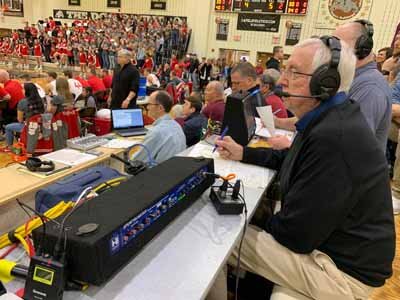Henry Engineering Sportscaster Review
In the last several years, small college, high school and amateur sports webcasts have become very popular.
I have produced hundreds of IHSAA sports broadcasts, most staffed by students. They call the game, run the cameras, and operate the gear.
Small prosumer cameras deliver an incredible point and shoot image. Much of the video gear (switchers, effects, storage) is PC-based, making it easy to install and use. I wish I could say the same for the audio!
The audio seems simple until you actually put a game on the air. A typical football game will have a director, two announcers, a spotter/statistician, and often a field reporter on the sidelines of the playing field.
There will be camera operators taking direction from the director who “calls the shots”. The director may also coach our student announcers who are learning how to call a live game.
So we have several mics to mix, which is easy. Any conventional mic mixer will do, and this is what the small and newbie production crews will try to use. Then it gets very complicated.
Everyone need headphones: the producer, director, announcers, spotter, field reporter, and camera ops. But everyone needs to hear something slightly different, so I need separate headphone mixes. I’ve used small mixers, one for each announcer, but it gets complicated to install and difficult to use. And we’re not done yet.
We need an intercom! Everyone needs to have an off-air “backchannel” to communicate without disrupting the live play-by-play. The director needs to coach the announcers. The spotter needs to quote player statistics into the announcers’ headphones. The director needs to cue the field reporter (independent of what he’s telling the announcers), and he’ll also need to direct the camera operators. Now I need to add this mishmash of multiple intercom channels into the headphone system. It becomes a nightmare of mixers, DAs, amps, home-brewed intercom switchers, and lots of wiring.
In early 2017, I discovered Henry Engineering’s Sports Pod. This product became a building- block in my quest to simplify the mess of audio gear I was hauling to each game. I had some ideas, so I called Hank Landsberg at Henry and gave him a laundry-list of all the things I was trying to accomplish. We determined there was a “big piece of the puzzle” that was missing: a “magic box” that would handle all the audio functions I needed for play-by-play. After numerous conversations, Hank and I refined what would become the SportsCaster. About 8 months later, I received the first unit.
The SportsCaster is a specialized mixer and audio controller. It mixes the mics (and other sources), but it also creates the different headphone mixes I need for the broadcast team. And it gives me a “three-button Intercom” so I can selectively communicate with the announcers, the field reporter, and the camera ops.
The SportsCaster is indeed a “magic box,” but it’s the combination of the SportsCaster and the Sports Pods that makes everything work together. Each announcer has his own Sports Pod, which lets him mix Program and Intercom audio in his headphones. He also has an Intercom button which lets him talk to the director, spotter, or other announcers.
The spotter also uses a Sports Pod. He uses his Intercom to give player statistics to the announcers, via their headphones, as they call the game. Sometimes we’ll use a 4th or 5th Sports Pod for a Time Out Coordinator or a Replay Official. They all daisy-chain together with cat5, so it’s easy to add them “on the fly” if they’re needed.
The SportsCaster has an isolated headphone mix for the field reporter. He can hear Program, plus my Intercom mic. I can “solo-cue” the field reporter without bothering anyone else. Ditto for the camera ops: With their isolated headphone mix and my Intercom, I tell them where to point the cameras.
There’s even a way for the announcers to chat, off-air, with the field reporter. If they want to air a player interview, they can cue each other then easily insert the sideline report to the coverage. It all works seamlessly because the Intercom is integrated with the headphone mixes.
SportsCaster also has three Auxiliary inputs. I use them for my crowd mic (for ambience), for mixing in the P.A. announcer, and for playing back pre-recorded bits (interviews, PSAs) during the broadcast. The unit’s Cue bus is handy for previewing these sources before they go on-air.
The SportsCaster has taken the hassle out of play-by-play audio. Our air talent and tech staff now understand that teamwork and communication is critical to a successful broadcast. The SportsCaster system has made that possible for the sports video that I produce. And best of all, it’s all in a compact 1-RU package!
For more information on the SportsCaster, please visit their site at www.henryeng.com.
Meet the Author, Rick Vanderwielen
Rick Vanderwielen is a distinguished alumnus of the College of Technology at Purdue University. He is a member of his high school’s hall of fame, was named 1 of the 100 most influential businessmen in Indiana, and has received several awards for business accomplishments.
He is a serial entrepreneur having owned 9 diverse companies. In 2000, he sold his ‘dot-com’ company and attempted to retire…at which he failed. He purchased a television station, created a regional sports network on Cable, and was a partner in Webstream Sports. Always technical, Rick is integrating and inventing with a slant on webcasting. He has created one of the largest Facebook groups supporting and sharing ideas about this emerging industry. You can reach him at: rickvanderwielen@gmail.com




